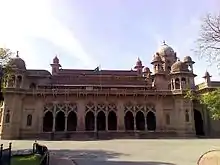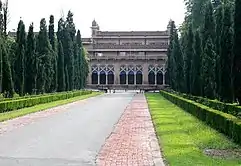Aitchison College
Aitchison College (Urdu: ایچیسن کالج) is an independent, semi-private boys school for boarding and day students from grade 1–13 in Lahore, Pakistan. It has a tradition of providing an education that uses academics, sports, and co-curricular activities as tools for character development. The school follows a curriculum designed to culminate in the International General Certificate of Education and AS Level/A Level qualifications and is geared towards preparing students for university education. The institute is the only Pakistani school that’s a member of the G20 Schools of the World. Aitchison has educated former Prime Ministers, the current Prime Minister of Pakistan Imran Khan, former President Farooq Leghari, lawyers, cricketers, and politicians.
| Aitchison College | |
|---|---|
 | |
 | |
| Location | |

| |
| Coordinates | 31.4578376°N 74.25387999999998°E |
| Information | |
| Former name | Punjab Chiefs' College |
| School type | Semi-Private Boarding school |
| Mottoes | Latin: "Iterum puer nobis" (Perseverance Commands Success) |
| Established | January 2, 1886 |
| Principal | Michael Thompson |
| Number of students | 1,100 (Senior school) 750 (Prep school) 1,000 (Junior school) |
| Area | 300-acre (120 ha) |
| Website | www |

It was originally formed on 2 January 1886 in then British India, as the Punjab Chiefs’ College and was renamed Aitchison College on 13 November 1886.[1] However, the inception of the college can be traced back to 1868 as the Wards School in Ambala, after which it became Chiefs’ College in Lahore.
Introduction
On 3 November 1886, the Viceroy Earl of Dufferin and Ava laid the foundation stone of the main building. The building was designed by Bhai Ram Singh and built by Sir Ganga Ram, one a leading architect and the other a leading builder of that time.[2]
The college is named after the then Lt. Governor of the Punjab, Sir Charles Umpherston Aitchison, who, addressing the students in 1888, said:
Much, very much, is expected of you. I trust you will use well the opportunities here afforded of you both for your education and for the formation of your character. ... This is an institution from which you will banish everything in thought and word and act that is mean, dishonorable or impure, and in which you will cultivate everything that is virtuous, true, manly and gentlemanly.[3]
Wards at Ambala
The history of Aitchison College goes back to the Ward's School at Ambala Cantonment which was envisioned in 1864 by Captain Tighe, then D.C. of Ambala. Established in 1868, it was originally intended for the education of young princes of the area but on the insistence of Sir Henry Davies - the Lieutenant Governor of the Punjab, it widened its scope in 1874 to cater for the education of all the other heirs of the Princely states living in other parts of Punjab. The present constitution of Aitchison College is still based on the set of rules framed for the Wards' School.
Because of this seamless history from the "Wards School" to the "Chiefs' College" to the "Aitchison College" the school is arguably 150 years old in 2018.
Chief's College
The growing interest in the college prompted efforts by Lt. Gen Sir Charles Umpherston Aitchison, after whom the college is named, to expand the Government Wards School into Chiefs College. North Mian Meer Road was initially selected as the new site for Chiefs College and collaboration between Bhai Ram Singh, Vice Principal of Mayo School of Arts and Colonel Sir Samuel Swinton Jacob, Executive Engineer at Jeypore came up with an architectural design for the college. Even at its beginning, the college was designed to have a science laboratory, library and museum besides classrooms and amenities for students. Under the auspices of the new staff, including the first Principal W. A. Robinson and the famous Urdu poet Altaf Hussain Hali, Chiefs College began educating a modest first batch of 12 boys, who were temporarily accommodated at Abbot Road while construction was in progress. The college was formally inaugurated by the Viceroy, the Earl of Dufferin and Ava on 3 November 1886.
Aitchison College
On 13 November 1886, a few days after the foundation stone of Chiefs College was laid, the school was renamed Aitchison College. Construction of the main building, now known as Old Building, began in 1887 and was finished in 1890, along with a gymnasium and a hospital. Soon after that, the main building became the center of academic life at Aitchison, moving classes away from their previous locations in the boarding houses and rented bungalows. Construction on other buildings continued as the school attracted more wards and princes.
Several efforts were made to provide facilities for physical education. In 1896, a cricket pavilion was built, and work began on a polo field. A year later, training in cricket, football, field hockey, and tennis was started. Following Aitchison's win in local sports competitions, the Aitchison Challenge Cup was established to honor the best sportsmen each year. In 1905, ACOBA (Aitchison College Old Boys Association) was established to allow the alumni of the school to compete against the current students in an event that brought together the alumni each year. In 1907, Aitchison College started sending contingents of sports teams to compete with schools outside Lahore and was allowed to host contingents from other schools. Swimming facilities were developed in 1923 and the Rani of Mandi Cup was established to honor the best swimmer of the year. The sports system soon evolved as competitions between the houses began in 1928. Hockey and tennis courts were established in 1938.
The school also offers several extra-curricular activities and awards. In the first half of the 20th century, the school began to offer awards to some of its top students, he most popular of which were those for best essay writer and best debater. Additionally, the first Rivaz medal for best leaving boy at Aitchison College was created in 1906. The school also first published "Pioneer" publication in 1936. The Prize Distribution Day ceremony, now known as Founders Day, held annually in May, was started in 1892. The Prize Distribution was later divided into two separate ceremonies: Founders Day Academics and Founders Day Sports.

The school also has a history of providing religious education and housing. A mosque was constructed for religious education of Muslim students in 1900, and a Dharamshala was created in 1913. A separate Sikh mess was organized in 1907, followed by the creation of a separate kitchen for Halal food in 1938. A mandir was also constructed, which was later redesigned to hold the Principal's office. Religious education was later made compulsory for Hindu and Sikh students. Until 1933, the school enforced a rule that separate boarding houses should exist for Muslims, Hindus, and Sikhs.
Aitchison College has also changed its building make-up over the years. A separate building for the Preparatory School, which now holds classes for grades 7–9, was constructed in 1915, and the prefects system was established two years later. The school became affiliated with Cambridge University in 1933. In 1935, the policy of admission was broadened to include ordinary boys from surrounding areas. Following this policy, a separate house, Jubilee, was established for day boys. Classes for grades 9–13 were shifted from the main building to the newly constructed Barry Block (Senior School) in 1948. Following the independence of Pakistan in 1947, Muhammad Ali Jinnah was appointed Patron in Chief of the college in 1948. A separate building for Junior School, for Grades 1–5, was built in 1964. War between India and Pakistan in 1965 disrupted school activities for a while but normal school year resumed soon after cease fire. A number of modern buildings were constructed on the campus near the end of the 20th century, including an amphitheater, a large library, computer and science laboratories, housing for staff members, a riding school, and squash and basketball courts.
See also
References
- "Aitchison College History". Archived from the original on 20 April 2014. Retrieved 12 March 2014.
- "Leading News Resource of Pakistan". Daily Times. Archived from the original on 18 October 2012. Retrieved 1 August 2012.
- Cited in the Punjab Civil & Military Gazette Lahore, ed of 5 November 1888
Further reading
- L. F. Loveday Prior "Punjab Prelude", London: John Murray, 1952.
- John Hill "Maharajas in the Making; Life at the Eton of India 1935-40", Sussex, 2001.
- F. S. Aijazuddin "Commanding Success", Lahore, 2011.